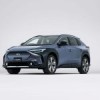THE AUDI TT OFFROAD CONCEPT
The Audi TT offroad concept breaks the mold, combining the sportiness of a coupe with the lifestyle and utility of a compact SUV.
The plug-in hybrid drive with two electric motors delivers 300 kW (408 hp) of system output and 650 Nm of system torque. The show car accelerates from 0 to 100 km/h (62.1 mph) in 5.2 seconds and reaches the electronically governed top speed of 250 km/h (155.3 mph) without any trouble. It consumes just 1.9 liters of fuel per 100 kilometers (123.8 US mpg), a CO2 equivalent of 45 grams per kilometer (72.4 g/mile). The Audi TT offroad concept can drive over 50 kilometers (31.1 miles) solely on electric power and thus with zero local emissions, and has a total range of up to 880 kilometers (546.8 miles).
 The combustion engine is a 2.0 TFSI producing 215 kW (292 hp) and 380 Nm of torque. The two-liter, four‑cylinder unit with the large turbocharger is packed with Audi’s potent efficiency technology. A separating clutch links the transverse 2.0 TFSI to an electric motor producing 40 kW and 220 Nm of torque. The slim, disc-shaped electric motor is integrated into the six-speed e‑S tronic. The dual-clutch transmission sends the torque to the front wheels. Mounted on the rear axle of the Audi TT offroad concept is a second electric motor independent of this drive unit. This produces a maximum of 85 kW and 270 Nm.
The combustion engine is a 2.0 TFSI producing 215 kW (292 hp) and 380 Nm of torque. The two-liter, four‑cylinder unit with the large turbocharger is packed with Audi’s potent efficiency technology. A separating clutch links the transverse 2.0 TFSI to an electric motor producing 40 kW and 220 Nm of torque. The slim, disc-shaped electric motor is integrated into the six-speed e‑S tronic. The dual-clutch transmission sends the torque to the front wheels. Mounted on the rear axle of the Audi TT offroad concept is a second electric motor independent of this drive unit. This produces a maximum of 85 kW and 270 Nm.
 In front of the rear axle is a liquid-cooled, lithium-ion battery comprising eight modules. It contributes to the balanced 54:46 weight distribution between the front and rear axles and to the low center of gravity. The battery stores up to 12 kWh of energy, enough for an electric range of 50 kilometers (31.1 miles). An Audi wall box, which manages the energy feed conveniently and intelligently and can deal with a variety of voltages and outlets, is used for stationary charging.
In front of the rear axle is a liquid-cooled, lithium-ion battery comprising eight modules. It contributes to the balanced 54:46 weight distribution between the front and rear axles and to the low center of gravity. The battery stores up to 12 kWh of energy, enough for an electric range of 50 kilometers (31.1 miles). An Audi wall box, which manages the energy feed conveniently and intelligently and can deal with a variety of voltages and outlets, is used for stationary charging.
 The show car is also designed for use with Audi Wireless Charging technology for contactless inductive charging. The infrastructure side – a plate with a coil and an inverter (AC/AC converter) – is placed on the parking spot of the Audi TT offroad concept and connected to the power grid. The charging process begins automatically when the car drives onto the plate. Charging stops automatically when the battery is fully charged. It takes about as long as charging via a cable, and the driver can interrupt the process at any time. The Audi Wireless Charging technology is more than 90 percent efficient, and is not affected by weather factors such as rain, snow or ice. The alternating field, which is only generated when a car is on the plate, is not harmful for people or animals.
The show car is also designed for use with Audi Wireless Charging technology for contactless inductive charging. The infrastructure side – a plate with a coil and an inverter (AC/AC converter) – is placed on the parking spot of the Audi TT offroad concept and connected to the power grid. The charging process begins automatically when the car drives onto the plate. Charging stops automatically when the battery is fully charged. It takes about as long as charging via a cable, and the driver can interrupt the process at any time. The Audi Wireless Charging technology is more than 90 percent efficient, and is not affected by weather factors such as rain, snow or ice. The alternating field, which is only generated when a car is on the plate, is not harmful for people or animals.
 The Audi drive select management system offers three driving modes. EV mode gives priority to electric driving. In this case, the front drive unit is inactive, and the electric motor at the rear axle with its powerful torque can rapidly accelerate the four‑door car to a maximum of 130 km/h (80.8 mph). In Hybrid mode, all three drives work together in various ways as necessary. In many situations the front electric motor assumes the role of a generator. Powered by the engine, it recharges the battery and thus extends the electric range. Full system output is available in Sport mode. During “boosting,” i.e. strong acceleration, the rear electric motor works together with the 2.0 TFSI. The same thing happens when the hybrid management system decides that all‑wheel drive is appropriate. In such situations, e.g. on a slippery road or in light off-road conditions, this essentially makes the Audi TT offroad concept an e‑tron quattro. When the driver takes his or her foot off the accelerator, free-wheeling or “coasting” is activated. Recuperation occurs here at low speeds and when braking. The driver can use the “Hold” and “Charge” functions in the MMI system to specifically influence the battery’s charge state, e.g. to increase storage of electric energy so that it can be used over the final kilometers to the destination.
The Audi drive select management system offers three driving modes. EV mode gives priority to electric driving. In this case, the front drive unit is inactive, and the electric motor at the rear axle with its powerful torque can rapidly accelerate the four‑door car to a maximum of 130 km/h (80.8 mph). In Hybrid mode, all three drives work together in various ways as necessary. In many situations the front electric motor assumes the role of a generator. Powered by the engine, it recharges the battery and thus extends the electric range. Full system output is available in Sport mode. During “boosting,” i.e. strong acceleration, the rear electric motor works together with the 2.0 TFSI. The same thing happens when the hybrid management system decides that all‑wheel drive is appropriate. In such situations, e.g. on a slippery road or in light off-road conditions, this essentially makes the Audi TT offroad concept an e‑tron quattro. When the driver takes his or her foot off the accelerator, free-wheeling or “coasting” is activated. Recuperation occurs here at low speeds and when braking. The driver can use the “Hold” and “Charge” functions in the MMI system to specifically influence the battery’s charge state, e.g. to increase storage of electric energy so that it can be used over the final kilometers to the destination.
 The Audi TT offroad concept show car features two Audi driver assistance systems that are almost ready for production: the intersection assistant and online traffic light information technology. The intersection assistant aims to help to avoid side-impact collisions, or reduce their severity, where lanes merge and at intersections. Radar sensors and a wide-angle video camera scan zones to the front and sides of the car. If the system detects a vehicle approaching from the side and assesses it to be critical, graduated warnings are displayed in the Audi virtual cockpit. Online traffic light information is a technology that connects the Audi TT offroad concept via the cell phone network to the central traffic computer, which controls the traffic light systems in the city. Based on the information from this system, the Audi virtual cockpit shows the driver what speed to drive in order to reach the next traffic light while it is green. The cockpit displays the time remaining when waiting for the light to turn green.
The Audi TT offroad concept show car features two Audi driver assistance systems that are almost ready for production: the intersection assistant and online traffic light information technology. The intersection assistant aims to help to avoid side-impact collisions, or reduce their severity, where lanes merge and at intersections. Radar sensors and a wide-angle video camera scan zones to the front and sides of the car. If the system detects a vehicle approaching from the side and assesses it to be critical, graduated warnings are displayed in the Audi virtual cockpit. Online traffic light information is a technology that connects the Audi TT offroad concept via the cell phone network to the central traffic computer, which controls the traffic light systems in the city. Based on the information from this system, the Audi virtual cockpit shows the driver what speed to drive in order to reach the next traffic light while it is green. The cockpit displays the time remaining when waiting for the light to turn green.
 Based on the versatile modular transverse matrix (MQB) and built on the ASF (Audi Space Frame) principle, the 4.39 meters (16.2 ft) long, 1.85 meters (6.1 ft) wide and a wheelbase of 2.63 meters (8.6 ft) concept resembles today’s compact SUV, the Audi Q3. At 1.53 meters (5.0 ft) tall, however, it is 8 centimeters (3.2 in) shorter, making its sporty character obvious at first glance.
Based on the versatile modular transverse matrix (MQB) and built on the ASF (Audi Space Frame) principle, the 4.39 meters (16.2 ft) long, 1.85 meters (6.1 ft) wide and a wheelbase of 2.63 meters (8.6 ft) concept resembles today’s compact SUV, the Audi Q3. At 1.53 meters (5.0 ft) tall, however, it is 8 centimeters (3.2 in) shorter, making its sporty character obvious at first glance.
 The design ideas of the new TT were also the inspiration for the sporty interior of the show car. The interior of the concept offers space for four. The power-folding individual rear seats allow for a nearly flat cargo floor. A large number of functions can be controlled via the multifunction steering wheel or the MMI terminal on the center tunnel console. The menu structure is oriented on a smart phone, with all key functions easy to reach. The driver can use finger gestures on the touchpad of the MMI terminal to zoom or scroll in lists and maps.
The design ideas of the new TT were also the inspiration for the sporty interior of the show car. The interior of the concept offers space for four. The power-folding individual rear seats allow for a nearly flat cargo floor. A large number of functions can be controlled via the multifunction steering wheel or the MMI terminal on the center tunnel console. The menu structure is oriented on a smart phone, with all key functions easy to reach. The driver can use finger gestures on the touchpad of the MMI terminal to zoom or scroll in lists and maps.
 The 12.3‑inch TFT display produces high-quality 3D graphics. The driver can customize the display with the push of a button. The classic view is dominated by the speedometer and the power meter for the plug‑in hybrid drive. In Infotainment mode, elements such as the navigation map or online traffic information displays take center stage. The Audi virtual cockpit also displays detailed information on charging with the Audi Wireless Charging technology.
The 12.3‑inch TFT display produces high-quality 3D graphics. The driver can customize the display with the push of a button. The classic view is dominated by the speedometer and the power meter for the plug‑in hybrid drive. In Infotainment mode, elements such as the navigation map or online traffic information displays take center stage. The Audi virtual cockpit also displays detailed information on charging with the Audi Wireless Charging technology.
 The show car is equipped with three Audi Smart Displays. The fast tablets serve as a mobile infotainment system for use inside and outside of the car. From DVD or TV streaming to controlling the radio or navigation planning, the Audi Smart Display is extremely versatile. One click on the “more” button in the start menu establishes an Internet connection via Audi connect at LTE speed. The user now has access to all of the functions of the Android operating system, from browsing with Google Chrome to visiting the Google Play store.
The show car is equipped with three Audi Smart Displays. The fast tablets serve as a mobile infotainment system for use inside and outside of the car. From DVD or TV streaming to controlling the radio or navigation planning, the Audi Smart Display is extremely versatile. One click on the “more” button in the start menu establishes an Internet connection via Audi connect at LTE speed. The user now has access to all of the functions of the Android operating system, from browsing with Google Chrome to visiting the Google Play store.
Related Posts :
Category: NEWS




















